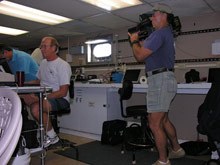
Videographer Dean Schweinler spent a week aboard the R/V Seward Johnson filming the science, ship, and submersible crew members as they went about their jobs. Here he is working on a segment about co-Principal Investigator John Reed, who is plotting the expedition's dive sites. An educational video will be produced from Mr. Schweinler's work. Click image for larger view and image credit.
Science Goes Hollywood
November 14, 2005
Tracy Griffin
High School Teacher
Brevard County, Florida
Elisabeth Jacobi
High School Teacher
Broward County, Florida
![]() View
video footage of how a dream came true for a marine science teacher. (Quicktime,
1.1 Mb.)
View
video footage of how a dream came true for a marine science teacher. (Quicktime,
1.1 Mb.)
Heading to sea and diving the depths in the Johnson-Sea-Link submersible is a dream come true for any marine science teacher. But our mission aboard the R/V Seward Johnson, since we so readily chose to accept it, is to help produce an educational video highlighting Florida deep-water corals. Once edited and complete, this video will ultimately be accessible to any and all interested teachers.

Teacher Tracy Griffin discusses the health of the Lophelia coral being kept in the onboard "cold room" with Principal Investigator Dr. Sandra Brooke. Click image for larger view and image credit.
Of course, the idea of shooting a video sounds glamorous, but it mostly involves a lot of hurry-up-and-wait scenarios and an infinite number of one-more-time scenarios. No dressing rooms or agents for this production. Instead, we find ourselves harassing crew members to utilize specific locations on the ship to shoot a scene. It's Hollywood meets the not-so-high seas, capturing the workings of a research cruise through a teacher's perspective. This experience has certainly opened our eyes to video production, seeing the world through the camera's perspective while battling seasickness and the frigid temperatures of the "cold room" where live specimens are kept onboard the ship.
There are lots of details in video production that can become cumbersome while onboard a ship. For example, simply walking in a straight line or maintaining the same lighting out on deck can lead to take after take. Sound can also become problematic as the wind blows past the microphone. Perhaps the most challenging, however, is the constant need to capture all aspects of research expedition life. Delaying a submersible launch just to get a good follow-up shot after the pre-launch briefing can result in eyes twitching and heads turning.

Teacher Elisabeth Jacobi exits the aft chamber of the Johnson-Sea-Link submersible, elated after her first deep sea dive. Click image for larger view and image credit.
Thankfully, the ship, submersible, and science crews are incredibly helpful with our pursuit, however annoying we may be at times. They realize how important it is to let people know not only what a research expedition entails, but to also inform the public and future scientists of the significant role these deep-water corals play in the marine ecosystem.
Once we return to our lives on land, we plan to incorporate our experiences and knowledge gained into lesson plans that can be shared with colleagues and ultimately inspire our students to learn more about the ever-evolving research into deep-water corals and life at sea. After all, it is our future scientists, and ships' and submersibles' crews who will lead this research in the not-so-distant future.
Sign up for the Ocean Explorer E-mail Update List.
























